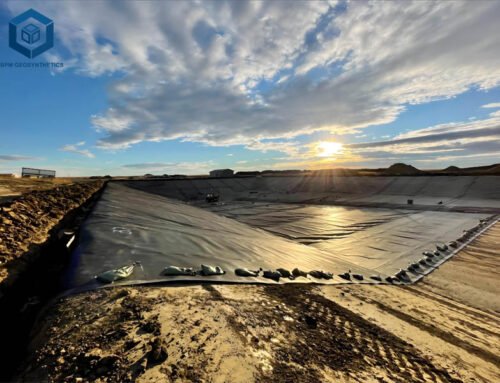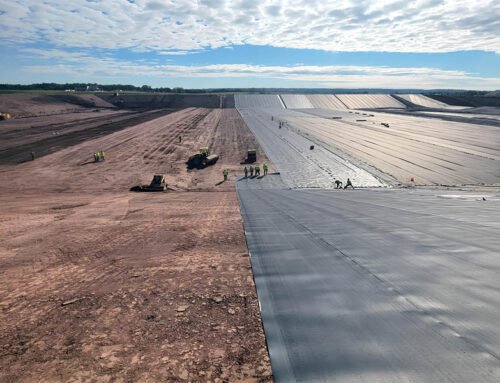Plastic Dam Liners, also known as a High-Density Polyethylene Geomembrane, is a type of geomembrane made from high-quality high-density polyethylene (HDPE). It is manufactured using a special formulation of virgin polyethylene resin, carbon black, antioxidants, anti-aging agents, and UV resistance components. These additives enhance the liner’s resistance to UV radiation, making it suitable for exposed conditions.
The Ultimate Guide To Choosing Plastic Dam Liners offers comprehensive insights into the key factors that need to be considered, from material selection to installation techniques. BPM Geomembrane, a trusted name in the geosynthetics industry, stands out as a reliable provider of high-quality dam liners. Their extensive range of products is designed to meet the specific needs of various projects, ensuring optimal performance and durability.
1. What Is Plastic Dam Liners?
Plastic dam liners are high-tech geosynthetic materials specifically designed for the construction and maintenance of water containment structures. These liners are typically made from advanced polymers such as High-Density Polyethylene (HDPE), Low-Density Polyethylene (LDPE), and other durable plastics, ensuring a reliable barrier against water seepage and contamination. Unlike traditional lining materials like concrete or compacted clay, plastic dam liners offer superior flexibility, durability, and cost-effectiveness. They are engineered to withstand harsh environmental conditions, including UV exposure, chemical corrosion, and temperature fluctuations, thereby extending the lifespan of dams and reducing maintenance costs.


2. What Are Functions Of Plastic Dam Liners?
The main functions of geomembranes in dams include anti-seepage, slope protection, anti-seepage curtains and seepage pressure release. Geomembrane is a membrane material made of synthetic resins such as polyethylene and polypropylene. It has excellent anti-seepage and anti-aging properties, can effectively prevent water penetration and leakage, and protect the safety and stability of the dam
2.1 Plastic Dam Liners – Anti-seepage
In dam projects, Plastic Dam Liners, as anti-seepage layers, can effectively prevent water from penetrating through bedrock or soil to ensure the stability of the dam. If the bedrock or soil of the dam itself has a large permeability, water will penetrate into the dam body and damage the stability of the dam. The use of geomembranes can avoid this situation and ensure the safety of the dam.
2.2 Plastic Dam Liners – Slope protection
Plastic Dam Liners can also be used for slope protection projects of dams. The dam surface and slope of the dam need to be protected to prevent scouring and erosion by water flow. Geomembrane has high tensile strength and wear resistance, can effectively resist the impact and erosion of water flow, and protect the dam surface and slope from being damaged.
2.3 Plastic Dam Liners – Anti-seepage curtain
In some special cases, the permeability of the bedrock or soil of the dam itself is high and cannot meet the anti-seepage requirements. At this time, geomembrane can be used as an anti-seepage curtain material, embedded in the bedrock or soil, to prevent water penetration. Geomembrane has good flexibility and adaptability, can adapt to bedrock or soil of different shapes and changes, and ensure the integrity and stability of the anti-seepage curtain.
2.4 Plastic Dam Liners – Seepage pressure release
During the long-term operation of the dam, due to changes in water pressure and groundwater level, a large seepage pressure will be generated. If the seepage pressure cannot be reasonably released, it will have an adverse effect on the dam. Geomembrane can be used to make seepage pressure release holes, and the seepage pressure is evenly released into the surrounding environment through the geomembrane material in the hole to ensure the stability and safety of the dam.
3. How to choosing Plastic Dam Liners?
The following aspects need to be considered when choosing geomembranes for dams:
3.1 Material selection:
Geomembranes are usually divided into two materials: HDPE (high-density polyethylene) and LDPE (low-density polyethylene). HDPE geomembranes have high tensile strength and durability, and are suitable for projects that bear large loads; while LDPE geomembranes are relatively soft and are suitable for projects that play a role in soil seepage and corrosion prevention.
3.2 Thickness selection:
The thickness of geomembranes is usually between 0.2mm and 2mm. Choose the appropriate thickness according to the requirements of the project. Generally, projects that bear large loads need to choose 1.5mm or 2.0mm geomembranes.
3.3 Strength requirements:
Different projects have different strength requirements for geomembranes, especially tensile strength and tear strength. According to the bearing capacity and environmental conditions of the project, choose geomembranes with sufficient strength.
3.4 Brand and price:
Choose regular brands and reputable manufacturers, while considering price and cost performance. Carefully check the relevant parameters and qualifications of the product to avoid purchasing inferior products that may affect the use effect and safety.
4. Construction Method – Plastic Dam Liners
Do not drag or pull the geomembrane during transportation to avoid being stabbed by sharp objects.
4.1 Prepare
- It should extend from the bottom to the high position, do not pull it too tight, and leave 1.50% margin to prepare for local sinking and stretching. Considering the actual situation of this project, the slope is laid from top to bottom;
- The longitudinal joints of two adjacent sections should not be on the same horizontal line, and should be staggered by more than 1m;
- The longitudinal joint should be more than 1.50m away from the dam foot and the bend foot, and should be set on the plane;
- Slope first and then the bottom of the field;
- When laying the slope, the film spreading direction should be basically parallel to the maximum slope line.
4.2 Laying
- Before laying the geomembrane, the corresponding qualified acceptance certificate of the civil engineering project should be obtained.
- Before cutting the geomembrane, its relevant dimensions should be accurately measured, and then cut according to the actual size. Generally, it is not suitable to cut according to the size. Each piece should be numbered and recorded in detail on a special form.
- When laying geomembranes, the number of welds should be minimized, and raw materials should be saved as much as possible while ensuring quality. It is also easy to ensure quality.
- The overlap width of the joints between membranes is generally not less than 10cm, and the welds are usually arranged in the direction parallel to the maximum slope, that is, arranged along the slope.
- Usually, the length of the joints should be shortened as much as possible in corners and deformed areas. Except for special requirements, no welds should be set within 1.5 meters from the top slope or stress concentration area on slopes with a slope greater than 1:6.
- When laying geomembranes, artificial wrinkles should be avoided. When the temperature is low, they should be tightened and laid flat as much as possible.
- After the geomembrane is laid, walking on the membrane surface, moving tools, etc. should be minimized. Any objects that can cause harm to the anti-seepage membrane should not be placed on the membrane or carried on the membrane to avoid accidental damage to the membrane.


5. Summary
When selecting Plastic Dam Liners, the specific needs and environmental conditions of the project should be fully considered to ensure that the selected model can meet the project requirements.
When purchasing Geo Fabric, you should choose products produced by regular manufacturers and check relevant documents such as product quality certificates and inspection reports to ensure that the product quality is reliable.The Best Project Material Co.,Ltd focuses on the production of geotextiles and one-stop services, and is a very reliable choice.During the construction process, the construction should be carried out strictly in accordance with relevant specifications and standards to ensure the correct laying and fixing of the geotextile to give full play to its protective and reinforcement functions.





